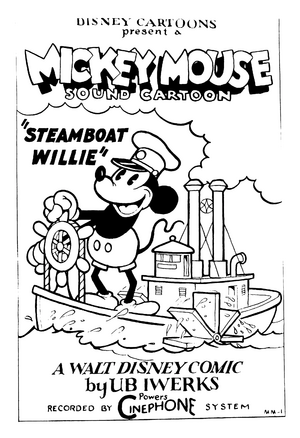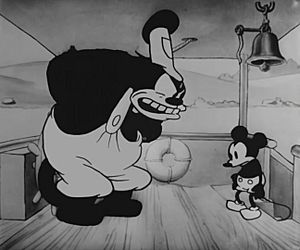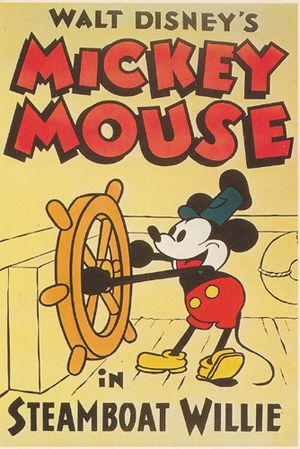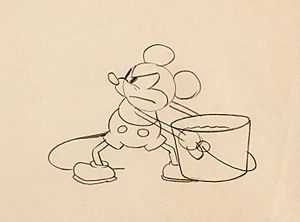Steamboat Willie facts for kids
Quick facts for kids Steamboat Willie |
|
|---|---|

The main poster of theaters
|
|
| Directed by | |
| Produced by |
|
| Story by |
|
| Starring | Walt Disney |
| Music by |
|
| Studio | Walt Disney Studio |
| Distributed by | Pat Powers (Celebrity Productions/Cinephone sound) |
| Release date(s) | November 18, 1928 (United States) |
| Running time | 7:47 |
| Country | United States |
| Language | English |
| Budget | $4,986.69 |
Steamboat Willie is a 1928 American animated short film directed by Walt Disney and Ub Iwerks. It was produced in black and white by Walt Disney Studios and was released by Pat Powers, under the name of Celebrity Productions. The cartoon is considered the debut of both Mickey and Minnie Mouse, although both characters appeared several months earlier in a test screening of Plane Crazy. Steamboat Willie was the third of Mickey's films to be produced, but it was the first to be distributed, because Disney, having seen The Jazz Singer, had committed himself to produce one of the first fully synchronized sound cartoons.
Steamboat Willie is especially notable for being one of the first cartoons with synchronized sound, as well as one of the first cartoons to feature a fully post-produced soundtrack, which distinguished it from earlier sound cartoons, such as Inkwell Studios' Song Car-Tunes (1924–1926) and Van Beuren Studios' Dinner Time (1928). Disney believed that synchronized sound was the future of film. Steamboat Willie became the most popular cartoon of its day.
Music for Steamboat Willie was arranged by Wilfred Jackson and Bert Lewis, and it included the songs "Steamboat Bill", a composition popularized by baritone Arthur Collins during the 1910s, and the 19th century popular song "Turkey in the Straw". The title of the film may be a parody of the Buster Keaton film Steamboat Bill, Jr. (1928), itself a reference to the song by Collins. Disney performed all of the voices in the film, although there is little intelligible dialogue.
The film has received wide critical acclaim, not only for introducing one of the world's most popular cartoon characters but also for its technical innovation. Animators voted Steamboat Willie as the 13th greatest cartoon of all time in the 1994 book The 50 Greatest Cartoons, and in 1998, the film was selected by the United States Library of Congress for preservation in the National Film Registry. The cartoon entered the public domain in the United States on January 1, 2024.
Contents
Background
Mickey Mouse was created as a replacement for Oswald the Lucky Rabbit, an earlier cartoon character that was created by the Disney studio but owned at the time by Universal Pictures. The first two Mickey Mouse films produced, silent versions of Plane Crazy and The Gallopin' Gaucho, had failed to gain a distributor. According to Roy O. Disney, Walt Disney was inspired to create a sound cartoon after watching The Jazz Singer (1927). Disney believed that adding sound to a cartoon would greatly increase its appeal.
Despite being recognized for it, Steamboat Willie was not the first cartoon with synchronized sound. Starting in May 1924 and continuing through September 1926, Dave and Max Fleischer's Inkwell Studios produced 19 sound cartoons, part of the Song Car-Tunes series, using the Phonofilm sound-on-film process. However, the Song Car-Tunes failed to keep the sound fully synchronized, while Steamboat Willie was produced using a click track to keep his musicians on the beat. As little as one month before Steamboat Willie was released, Paul Terry released Dinner Time, which also used a soundtrack, but Dinner Time was not a financial success.
In June 1927, producer Pat Powers made an unsuccessful takeover bid for Lee de Forest's Phonofilm Corporation. In the aftermath, Powers hired a former DeForest technician, William Garrity, to produce a cloned version of the Phonofilm system, which Powers dubbed "Powers Cinephone". By then, de Forest was in too weak a financial position to mount a legal challenge against Powers for patent infringement. Powers convinced Disney to use Cinephone for Steamboat Willie; their business relationship lasted until 1930 when Powers and Disney had a falling-out over money, and Powers hired away Disney's lead animator, Ub Iwerks.
Plot
At the start of the film, Mickey Mouse pilots a steam river sidewheeler. He cheerfully whistles "Steamboat Bill" and sounds the boat's three whistles. Soon, the captain, Pete, appears and orders Mickey off the bridge. Mickey blows a raspberry at Pete. Pete attempts to kick him, but Mickey rushes away in time and Pete accidentally kicks himself in the rear. Mickey falls down the stairs, slips on a bar of soap on the boat's deck, and lands in a bucket of water. A parrot laughs at him and Mickey throws the bucket on its head.
Pete, who has been watching the occurrence, pilots the steamboat himself. He bites off some chewing tobacco and spits into the wind. The spit flies backward and rings the boat's bell. Amused, Pete spits again, but this time the spit hits him in the face, making him upset.
The steamboat makes a stop at "Podunk Landing" to pick up a cargo of various livestock. Mickey has trouble getting one of the slimmer cows onto the boat attached to a harness. To solve this, Mickey fills the cow's stomach up with hay to fatten the slim cow into the harness. Just as they set off again, Minnie Mouse appears, running to catch the boat before it leaves. Mickey does not see her in time, but she runs after the boat along the shore calling out Mickey's name. Mickey hears Minnie's calls and he takes her on board by hooking the cargo crane to her bloomers.
Landing on deck, Minnie accidentally drops a ukulele and some sheet music for the song "Turkey in the Straw", which are eaten by a goat. Mickey fights with the goat over the eaten ukulele, but Mickey lets go of it. The goat suddenly goes dizzy over the use of force, and the two mice begin using the goat's body as a phonograph, which they play by turning its tail like a crank. This makes the two mice laugh. Mickey uses various objects on the boat as percussion accompaniment and "plays" the animals like musical instruments. This includes pulling the tail of a cat, stretching a goose's throat, tugging on the tails of baby pigs, playing with the teats of the mother pig, and using a cow's teeth and tongue to play the song as a xylophone.
Captain Pete is unamused by the musical act and puts Mickey to work peeling potatoes as a punishment. In the potato bin, the same parrot that laughed at him earlier appears in the porthole and laughs at him again. Fed up with the bird's heckling, Mickey throws a half-peeled potato at it, knocking it back into the river below. The film ends with Mickey laughing as he sits next to the potatoes.
Dialogue
Mickey, Minnie, and Pete perform in near-pantomime, with growls and squeaks but no intelligible dialogue. The only dialogue in the film is spoken by the ship's parrot. When Mickey falls into a bucket of soapy water, the bird says, "Hope you don't feel hurt, big boy! Ha ha ha ha ha!". At the end of the short, the parrot repeats the phrase, and after it falls into the water, it cries, "Help! Help! Man overboard!".
Production

The production of Steamboat Willie took place between July and September 1928, which according to Roy O. Disney's personal notes had a budget of $4,986.69, including the prints for movie theaters. There was initially some doubt among the animators that a sound cartoon would appear believable enough, so before a soundtrack was produced, Disney arranged for a screening of the film to a test audience with live sound to accompany it. This screening took place on July 29, with Steamboat Willie only partly finished. The audience sat in a room adjoining Walt Disney's office. His brother Roy placed the movie projector outdoors and the film was projected through a window so that the sound of the projector would not interfere with the live sound. Ub Iwerks set up a bedsheet behind the movie screen behind which he placed a microphone connected to speakers where the audience would sit. The live sound was produced from behind the bedsheet. Wilfred Jackson played the music on a mouth organ, Ub Iwerks banged on pots and pans for the percussion segment, and Johnny Cannon provided sound effects with various devices, including slide whistles and spittoons for bells. Walt Disney provided what little dialogue there was to the film, mostly grunts, laughs, and squawks. After several practices, they were ready for the audience, which consisted of Disney employees and their wives.
The response of the audience was extremely positive, and it gave Walt Disney the confidence to move forward and complete the film. He said later in recalling this first viewing,
The effect on our little audience was nothing less than electric. They responded almost instinctively to this union of sound and motion. I thought they were kidding me. So they put me in the audience and ran the action again. It was terrible, but it was wonderful! And it was something new!
Iwerks said, "I've never been so thrilled in my life. Nothing since has ever equaled it."
Walt Disney traveled to New York City to hire a company to produce the sound system. He eventually settled on Pat Powers's Cinephone system, created by Powers using an updated version of Lee de Forest's Phonofilm system, without giving De Forest any credit, a decision that Powers later regretted.
The music in the final soundtrack was performed by the Green Brothers Novelty Band and was conducted by Carl Edouarde. Joe and Lew Green from the band also assisted in timing the music to the film. The first attempt to synchronize the recording with the film, done on September 15, 1928, was a disaster. Disney had to sell his Moon roadster in order to finance a second recording. This was a success, with the addition of a filmed bouncing ball to keep the tempo.
In other media
Television and film
The fourth-season 1992 episode of The Simpsons "Itchy & Scratchy: The Movie" features a short parody of the opening scene of Steamboat Willie entitled Steamboat Itchy.
In the 1998 film Saving Private Ryan, set in 1944, a German prisoner of war, nicknamed "Steamboat Willie", tries to win the sympathy of his American captors by talking about Mickey Mouse.
In the 2008 movie of the TV series Futurama called The Beast with a Billion Backs, the opening is a parody of Steamboat Willie.
As part of their 100-year anniversary, in July 2023, Disney released a The Wonderful World of Mickey Mouse special and series finale entitled Steamboat Silly featuring multiple copies of Mickey as he appears in this short.
Video games
Steamboat Willie-themed levels are featured in the video games Mickey Mania (1994), Kingdom Hearts II (2005), and Epic Mickey (2010). An alternate Steamboat Willie-themed costume of Kingdom Hearts' Sora was featured in Super Smash Bros. Ultimate (2018). The Steamboat Willie versions of Mickey Mouse and Pete are featured as playable racers in Disney Speedstorm (2023).
Other use by Disney
In 1993, to Coincide with the Opening of Mickey's Toontown in Disneyland, a shortened cover of the cartoon's music was arranged to be featured in the land's background ambiance.
In 2007, a Steamboat Willie clip of Mickey whistling started being used for Walt Disney Animation Studios' production logo.
In 2019, Lego released an official Steamboat Willie set to commemorate the 90th anniversary of Mickey Mouse.
The whistle in the film has been used to make sound in the Mickey & Minnie's Runaway Railway attraction, which opened at Disneyland in January 2023.
Release history
Theatrical
- July 1928 – First sound test screening (Silent with live sound)
- September 1928 – First attempt to synchronize the recording on the film
- November 1928 – Original theatrical release with final soundtrack
- 1972 – The Mouse Factory, episode #33: "Tugboats" (TV)
- 1990s – Mickey's Mouse Tracks, episode #45 (TV)
- 1996 – Mickey's Greatest Hits
- 1997 – Ink & Paint Club, episode #2 "Mickey Landmarks" (TV)
- Ongoing – Main Street Cinema at Disneyland
Cuts
In the 1950s, Disney removed a scene in which Mickey tugs on the tails of the baby pigs, picks up the mother and kicks them off her teats, and plays her like an accordion, since television distributors deemed it inappropriate. Since then, the full version of the film was included on the 1998 compilation VHS The Spirit of Mickey and the Walt Disney Treasures DVD set "Mickey Mouse in Black and White", as well as on Disney+.
Home media
- 1984 – Cartoon Classics: Limited Gold Editions: Mickey (VHS)
- 1998 – The Spirit of Mickey (VHS)
- 2001 – The Hand Behind the Mouse: The Ub Iwerks Story (VHS)
- 2002 – Walt Disney Treasures: Mickey Mouse in Black and White
- 2005 – Vintage Mickey (DVD)
- 2007 – Walt Disney Treasures: The Adventures of Oswald the Lucky Rabbit.
- 2009 – Snow White and the Seven Dwarfs (Blu-ray)
- 2018 – Celebrating Mickey 90th-anniversary compilation (Blu-ray/DVD/Digital)
- Celebrating Mickey was reissued in 2021 as part of the U.S. Disney Movie Club exclusive The Best of Mickey Collection along with Fantasia and Fantasia 2000 (Blu-ray/DVD/Digital).
- 2019 – Disney+ (streaming online)
- 2023 – Mickey & Minnie: 10 Classic Shorts – Volume 1 95th-anniversary compilation (Blu-ray/DVD/Digital)
See also
- Mickey Mouse (film series)



